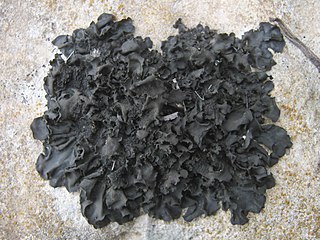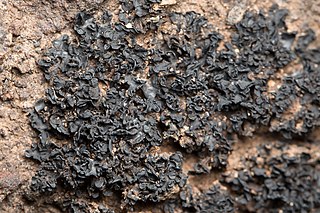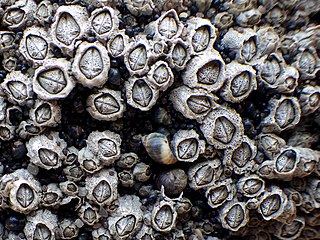
Collema is a genus of lichens in the family Collemataceae. The photobiont is the cyanobacterium genus Nostoc. Species in this genus typically grow on nutrient-rich bark or somewhat siliceous or calcareous rocks in humid environments.

The Lichinaceae are a family of ascomycete fungi. Most species are lichenized with cyanobacteria, and have a distribution largely in temperate regions.

Ptychographa is a genus of lichenized fungi in the family Xylographaceae. It is a monotypic genus, containing the single species Ptychographa xylographoides. Both the species and genus were described as new in 1874 by Finnish botanist William Nylander.
Tremotylium is a genus of lichen-forming fungi in the family Graphidaceae. The genus was circumscribed by Finnish lichenologist William Nylander in 1865, but it was not published validly. He validated the genus and assigned T. angolense as the type species in 1868.

Calicium is a genus of leprose lichens. It is in the family Caliciaceae, and has 40 species.

Xanthopyreniaceae is a family of lichen-forming fungi in the order Collemopsidiales. The family was circumscribed by lichenologist Alexander Zahlbruckner in 1926.
Tylophoron is a genus of lichen-forming fungi in the family Arthoniaceae. The genus was circumscribed in 1862 by Finnish lichenologist William Nylander.
Frigidopyrenia is a fungal genus in the family Xanthopyreniaceae. It is a monotypic genus, containing the single species Frigidopyrenia bryospila, a subarctic crustose lichen. This lichen was originally described by Finnish lichenologist William Nylander in 1864 as Verrucaria bryospila. It was shuffled to several genera in its taxonomic history before Martin Grube circumscribed Frigidopyrenia in 2005 to contain it. As of 2017, no molecular sequence data was available for Frigidopyrenia.

Collemopsidium is a genus of fungi in the family Xanthopyreniaceae. Some members of this genus are marine species, and described as "borderline lichens" or "algicolous" fungi. The genus was circumscribed by Finnish botanist William Nylander in 1881.
Euopsis is a genus of lichen-forming fungi in the family Harpidiaceae. The genus contains two species. The genus was circumscribed by Finnish botanist William Nylander in 1881.

Hypocenomyce is a genus of lichen-forming fungi in the family Ophioparmaceae. Species in the genus grow on bark and on wood, especially on burned tree stumps and trunks in coniferous forest. Hypocenomyce lichens are widely distributed in the northern hemisphere.

Dactylina is a genus of lichen-forming fungi in the family Parmeliaceae. The genus was circumscribed by Finnish botanist William Nylander in 1860, with Dactylina arctica assigned as the type species.

Varicellaria is a genus of crustose lichens. It is the only genus in the family Varicellariaceae.

Schaereria is a genus of lichen-forming fungi. It is the sole genus in the family Schaereriaceae, which itself is the only family in the Schaereriales, an order in the subclass Ostropomycetidae of the class Lecanoromycetes. Most Schaereria species are crustose lichens that live on rocks. Schaereria was first proposed by Gustav Wilhelm Körber in 1855 and was later taken up by other lichenologists despite periods of disuse.

Sporastatia is a genus of crustose lichens in the family Sporastatiaceae. It has four species. Sporastatia lichens are long-lived species that grow on siliceous or weakly calcareous rocks in arctic and alpine locales.

Parmelia fraudans is a species of foliose lichen in the family Parmeliaceae. It is found in Europe and North America, where it grows on rocks.
Sporodictyon is a genus of crustose lichens in the family Verrucariaceae. It has 10 species. Most species grow on rocks, although some have been recorded overgrowing soil and mosses.

Thelenellaceae is a family of lichen-forming fungi. It is the sole family in the monotypic order Thelenellales, and contains three genera and about 50 species.
Pyrenidium is a genus of lichenicolous (lichen-dwelling) fungi. It is the only genus in the family Pyrenidiaceae. It has 13 species.











